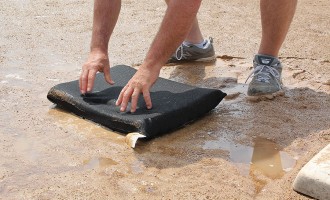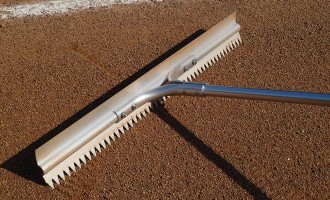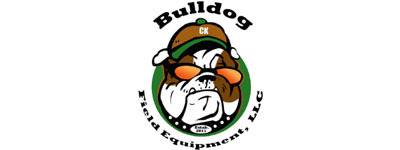Drying agents are a must-have tool for dealing with rain situations but be sure to use them correctly in order to use the least amount and get the biggest bang for your buck. These products aren’t cheap and a rainy season can have you plowing through budget dollars in no time if your crew is not careful with when, where and how they are using the product. Here are a few things to keep in mind.
When to use drying agent
Before applying drying agent to a wet field be sure you’ve removed as much of the free water on the surface as possible using Super Soppers, Puddle Pumps and Puddle Sponges to suck up the standing water.
Where to use drying agent
In-game, apply it wherever it is needed in order to keep a game moving along. In a game day field prep situation, if the field is wet but your humidity is lowering and you have a breeze and/ or sun to help out, hold on to the drying agent and let nature do some of the work. Only apply drying agent after you’ve been able to thoroughly inspect the skin areas and consider where you are going to need help with drying agent due to deep saturation.
How to use drying agent
- Back-rake (pushing the rake backwards) using a lute rake to fluff up the topdressing layer only in order to try to dry out that layer. You should only be penetrating down a 1/4″ to 1/2″ deep.
- In the wettest areas apply a calcined clay drying agent. You can use either the finer drying agent grade or, better yet, use the professional grade so that it blends into the topdressing better from a size standpoint. The coarser professional grades are also less dusty then the finer drying agents making them more worker friendly. No matter the gradation of the calcined clay product, they are excellent absorbents for water on the field.
- Only apply a little at a time and then blend in with the existing topdressing using your lute rakes. You can always add more so avoid the temptation to just dump a whole bag unless the situation REALLY calls for it.
- Over-application of drying agents usually takes place with in-game situations when you don’t have time to address the situation properly. If over application occurs, it is wise to go back after the game and remove excess amounts of the calcined clay as too much calcined clay can affect how your infield responds to its normal daily moisture management or future rain events. The removed material can be dried and reused at a later date or incorporated into your topdressing blend (if you use calcined clay in it) in the future.








